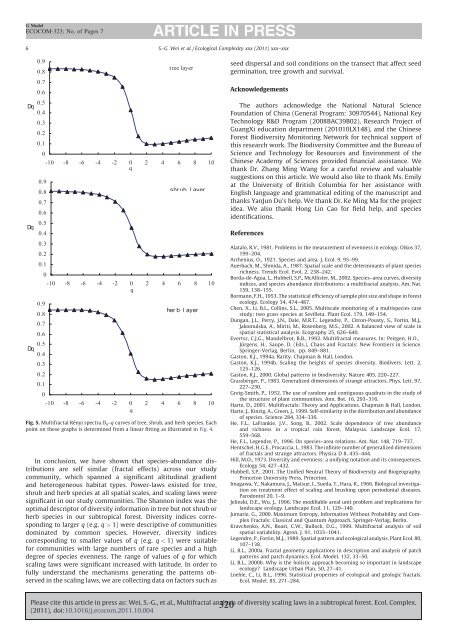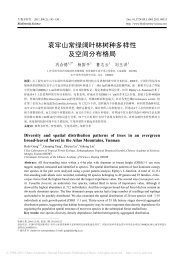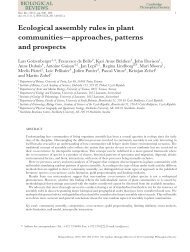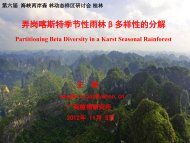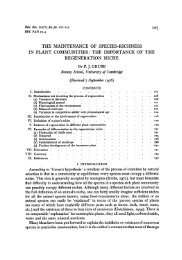Contents - ä¸å½æ£®æçç©å¤æ ·æ§çæµç½ç»
Contents - ä¸å½æ£®æçç©å¤æ ·æ§çæµç½ç»
Contents - ä¸å½æ£®æçç©å¤æ ·æ§çæµç½ç»
- No tags were found...
Create successful ePaper yourself
Turn your PDF publications into a flip-book with our unique Google optimized e-Paper software.
G ModelECOCOM-323; No. of Pages 76S.-G. Wei et al. / Ecological Complexity xxx (2011) xxx–xxxseed dispersal and soil conditions on the transect that affect seedgermination, tree growth and survival.AcknowledgementsThe authors acknowledge the National Natural ScienceFoundation of China (General Program: 30970544), National KeyTechnology R&D Program (2008BAC39B02), Research Project ofGuangXi education department (201010LX148), and the ChineseForest Biodiversity Monitoring Network for technical support ofthis research work. The Biodiversity Committee and the Bureau ofScience and Technology for Resources and Environment of theChinese Academy of Sciences provided financial assistance. Wethank Dr. Zhang Ming Wang for a careful review and valuablesuggestions on this article. We would also like to thank Ms. Emilyat the University of British Columbia for her assistance withEnglish language and grammatical editing of the manuscript andthanks YanJun Du’s help. We thank Dr. Ke Ming Ma for the projectidea. We also thank Hong Lin Cao for field help, and speciesidentifications.ReferencesFig. 5. Multifractal Rényi spectra D q –q curves of tree, shrub, and herb species. Eachpoint on these graphs is determined from a linear fitting as illustrated in Fig. 4.In conclusion, we have shown that species-abundance distributionsare self similar (fractal effects) across our studycommunity, which spanned a significant altitudinal gradientand heterogeneous habitat types. Power-laws existed for tree,shrub and herb species at all spatial scales, and scaling laws weresignificant in our study communities. The Shannon index was theoptimal descriptor of diversity information in tree but not shrub orherb species in our subtropical forest. Diversity indices correspondingto larger q (e.g. q > 1) were descriptive of communitiesdominated by common species. However, diversity indicescorresponding to smaller values of q (e.g. q < 1) were suitablefor communities with large numbers of rare species and a highdegree of species evenness. The range of values of q for whichscaling laws were significant increased with latitude. In order tofully understand the mechanisms generating the patterns observedin the scaling laws, we are collecting data on factors such asAlatalo, R.V., 1981. Problems in the measurement of evenness in ecology. Oikos 37,199–204.Arrhenius, O., 1921. Species and area. J. Ecol. 9, 95–99.Auerbach, M., Shmida, A., 1987. Spatial scale and the determinants of plant speciesrichness. Trends Ecol. Evol. 2, 238–242.Borda-de-Agua, L., Hubbell, S.P., McAllister, M., 2002. Species–area curves, diversityindices, and species abundance distributions: a multifractal analysis. Am. Nat.159, 138–155.Bormann, F.H., 1953. The statistical efficiency of sample plot size and shape in forestecology. Ecology 34, 474–487.Chen, X., Li, B.L., Collins, S.L., 2005. Multiscale monitoring of a multispecies casestudy: two grass species at Sevilleta. Plant Ecol. 179, 149–154.Dungan, J.L., Perry, J.N., Dale, M.R.T., Legendre, P., Citron-Pousty, S., Fortin, M.J.,Jakomulska, A., Miriti, M., Rosenberg, M.S., 2002. A balanced view of scale inspatial statistical analysis. Ecography 25, 626–640.Evertsz, C.J.G., Mandelbrot, B.B., 1992. Multifractal measures. In: Peitgen, H.O.,Jürgens, H., Saupe, D. (Eds.), Chaos and Fractals: New Frontiers in Science.Springer-Verlag, Berlin, pp. 849–881.Gaston, K.J., 1994a. Rarity. Chapman & Hall, London.Gaston, K.J., 1994b. Scaling the heights of species diversity. Biodivers. Lett. 2,125–126.Gaston, K.J., 2000. Global patterns in biodiversity. Nature 405, 220–227.Grassberger, P., 1983. Generalized dimensions of strange attractors. Phys. Lett. 97,227–230.Greig-Smith, P., 1952. The use of random and contiguous quadrats in the study ofthe structure of plant communities. Ann. Bot. 16, 293–316.Harte, D., 2001. Multifractals: Theory and Applications. Chapman & Hall, London.Harte, J., Kinzig, A., Green, J., 1999. Self-similarity in the distribution and abundanceof species. Science 284, 334–336.He, F.L., LaFrankie, J.V., Song, B., 2002. Scale dependence of tree abundanceand richness in a tropical rain forest, Malaysia. Landscape Ecol. 17,559–568.He, F.L., Legendre, P., 1996. On species–area relations. Am. Nat. 148, 719–737.Hentschel, H.G.E., Procaccia, I., 1983. The infinite number of generalized dimensionsof fractals and strange attractors. Physica D 8, 435–444.Hill, M.O., 1973. Diversity and evenness: a unifying notation and its consequences.Ecology 54, 427–432.Hubbell, S.P., 2001. The Unified Neutral Theory of Biodiversity and Biogeography.Princeton University Press, Princeton.Imagawa, Y., Nakamura, J., Matsue, I., Sueda, T., Hara, K., 1966. Biological investigationon treatment effect of scaling and brushing upon periodontal diseases.Parodontol 20, 1–9.Jelinski, D.E., Wu, J., 1996. The modifiable areal unit problem and implications forlandscape ecology. Landscape Ecol. 11, 129–140.Jumarie, G., 2000. Maximum Entropy, Information Without Probability and ComplexFractals: Classical and Quantum Approach. Springer-Verlag, Berlin.Kravchenko, A.N., Boast, C.W., Bullock, D.G., 1999. Multifractal analysis of soilspatial variability. Agron. J. 91, 1033–1041.Legendre, P., Fortin, M.J., 1989. Spatial pattern and ecological analysis. Plant Ecol. 80,107–138.Li, B.L., 2000a. Fractal geometry applications in description and analysis of patchpatterns and patch dynamics. Ecol. Model. 132, 33–50.Li, B.L., 2000b. Why is the holistic approach becoming so important in landscapeecology? Landscape Urban Plan. 50, 27–41.Loehle, C., Li, B.L., 1996. Statistical properties of ecological and geologic fractals.Ecol. Model. 85, 271–284.Please cite this article in press as: Wei, S.-G., et al., Multifractal analysis of diversity scaling laws in a subtropical forest. Ecol. Complex.320(2011), doi:10.1016/j.ecocom.2011.10.004


